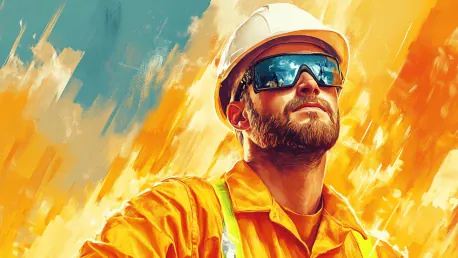With climate change contributing to unprecedented temperature rises, ensuring worker safety during extreme summer heat has become more critical than ever. According to recent data from the National Oceanic and Atmospheric Administration (NOAA), July 2023 was the hottest month on record. As temperatures escalate, the risks associated with heat exposure for outdoor and industrial workers increase significantly, warranting proactive measures to protect their health and well-being.
Establishing a Comprehensive Heat Safety Plan
Modified Work Environments
One of the fundamental aspects of ensuring worker safety during extreme summer heat is modifying work environments to reduce heat exposure. Implementing shaded rest areas, possibly using temporary structures, can significantly mitigate the risks for tasks conducted in direct sunlight. These areas should be equipped with amenities to create a cooler environment, such as large fans or portable evaporative coolers, especially in enclosed or semi-enclosed workspaces and break areas. Shading reduces direct sun exposure, which is a major contributor to heat-related illnesses.
Adjusting work schedules to avoid the hottest parts of the day is another effective strategy. Scheduling heavy labor tasks during the early morning or late afternoon when temperatures are relatively lower can help prevent overheating. Additionally, consider rotating workers to ensure no individual is exposed to extreme heat for prolonged periods. Employers should also be prepared to alter or even cease operations when weather conditions reach extreme heat thresholds to prevent potentially fatal heat-related incidents.
Hydration Protocols
Maintaining proper hydration is vital for workers in high-temperature environments. It is essential to ensure that job sites provide easy access to cool drinking water. Encouraging workers to drink small amounts frequently is crucial, as dehydration can occur quickly and without warning. Employers should also promote taking breaks in shaded or air-conditioned areas to allow the body to cool down and rehydrate effectively.
Establishing clear hydration protocols helps workers understand the importance of regular fluid intake. Providing electrolyte-replenishing beverages can also be beneficial, especially for workers who sweat extensively. Implementing mandatory hydration breaks, where everyone stops work to drink water, can enforce this practice. It’s also important to educate workers about recognizing the early signs of dehydration and heat stress, ensuring immediate action can be taken to prevent more severe heat-related illnesses.
Scheduled Breaks
Creating a schedule that includes regular breaks is a crucial component of a heat safety plan. Establishing extreme heat thresholds to determine when mandatory breaks, modified schedules, or work cessation are necessary based on weather conditions aids in quick decision-making. This preparedness ensures that when the heat reaches dangerous levels, workers have the necessary rest periods to recover and avoid heat-related injuries or illnesses.
Break schedules should be flexible and responsive to real-time weather data. Utilizing mobile apps or weather monitoring tools can provide up-to-date information on heat indexes, helping managers make informed decisions. Moreover, implementing a buddy system where workers keep an eye on each other can help identify early signs of heat stress, prompting timely breaks and interventions. This collective vigilance and systematic break scheduling significantly enhance overall workplace safety during extreme summer heat.
Selecting the Right Personal Protective Equipment (PPE)
Breathable and Lightweight Clothing
Personal Protective Equipment (PPE) plays a critical role in managing heat discomfort while protecting workers from various hazards. Breathable and lightweight clothing is essential for workers dealing with extreme temperatures. Moisture-wicking workwear is particularly effective as it draws sweat away from the skin, allowing for rapid evaporation and cooling. This type of clothing helps regulate body temperature and keeps workers dry.
Avoiding cotton garments, which tend to retain moisture, is also recommended. Instead, opt for synthetic or blended fabrics designed for high performance and moisture management. Additionally, clothing with built-in UV protection can provide an extra layer of defense against harmful sun exposure, further ensuring worker comfort and safety. Employers should regularly assess and refresh their PPE offerings to ensure they meet current safety standards and climatic demands.
Neck Gaiters and Breathable Boots
Neck gaiters serve as versatile PPE, offering sun protection and cooling benefits. When soaked in cold water, they can provide a cooling effect, making them an invaluable accessory in high-heat environments. Neck gaiters that pull sweat away from the body also help in managing heat stress by keeping the skin dry and reducing the risk of chafing and irritation.
Selecting breathable boots is equally important as appropriate footwear can significantly enhance comfort and safety in extreme temperatures. Safety footwear with insoles designed for ventilation helps keep feet cool and dry, preventing heat-related foot problems. Features like tri-directional traction lugs and a well-defined heel breast ensure stability and reduce the risk of slips and falls. Ensuring workers have access to breathable and protective footwear is a key component of an effective heat safety strategy.
Continuous Monitoring and Improvement
Regular Review and Feedback
An effective heat safety program is not static; it requires ongoing monitoring and improvements based on feedback and incident reports. Regularly reviewing the safety program helps identify areas for enhancement, ensuring measures remain effective and adapt to changing conditions. Worker feedback is invaluable in this process as those on the ground can provide insights into what works and areas needing adjustments.
Encouraging workers to report heat-related symptoms and offer suggestions for improvement fosters a proactive safety culture. Analyzing incident data to identify patterns and recurring issues allows safety professionals to implement targeted interventions. By maintaining an open line of communication and continuously refining safety measures, employers can better protect their workforce from the dangers of extreme summer heat.
Training and Education
With climate change driving unprecedented temperature increases, safeguarding worker safety during extreme summer heat is more essential than ever. Data from the National Oceanic and Atmospheric Administration (NOAA) indicates that July 2023 was the hottest month on record. As temperatures continue to rise, the dangers associated with heat exposure for outdoor and industrial workers become more pronounced. This escalating climate trend necessitates proactive measures to protect their health and well-being.
To combat these rising risks, employers and policymakers must implement strategies such as providing adequate hydration, ensuring access to shaded areas, and scheduling shifts to avoid the hottest parts of the day. Heat stress monitoring and educational programs on recognizing early symptoms of heat-related illnesses can also play a crucial role. Collaborative efforts between businesses, labor unions, and government agencies can foster a safer working environment. By prioritizing these measures, we can help mitigate the impacts of extreme heat on the workforce, ensuring workers remain safe and healthy amid climbing temperatures.









